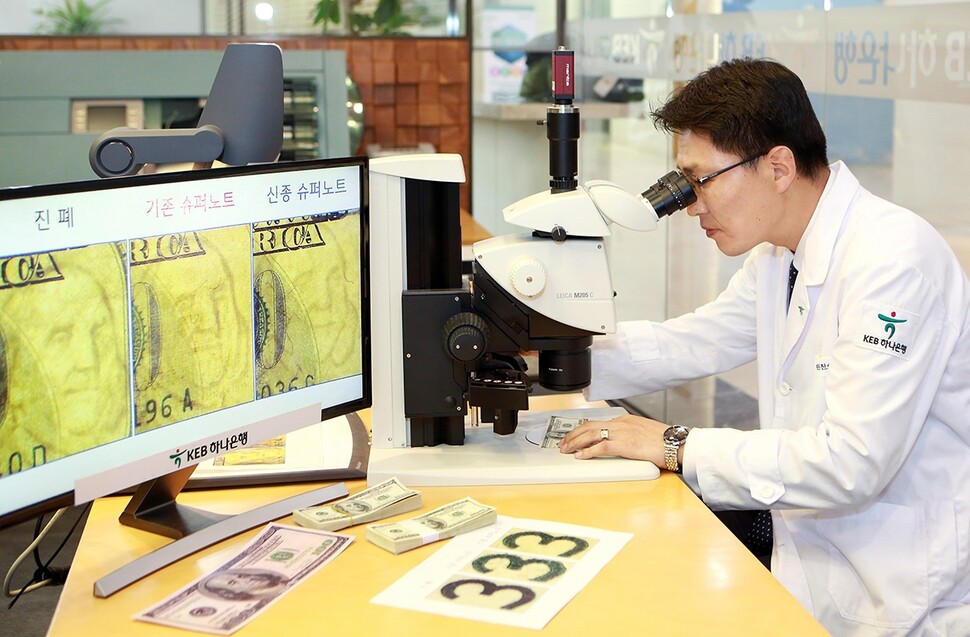hankyoreh
Links to other country sites 다른 나라 사이트 링크
KEB Hana Bank discovers first known example of new US$100 “supernote”

KEB Hana Bank announced on Dec. 6 that it had discovered the first example in the world of a new type of US$100 “supernote,” a high-quality counterfeit bill. New series of US dollars are issued with different signatures when the Secretary of the Treasury changes. The supernote in question was a copy of the 2006 series.
“Early last year, a suspected counterfeit dollar bill at a branch in Seoul was separated out with a regular identification device and underwent visual scanning before being sent to the main branch’s counterfeiting response center,” a Hana Bank source said.
“After video deciphering, the center concluded that a detailed identification would be needed. The original was obtained, and detailed analysis showed that it was a supernote,” the source added.
“Apparently the same conclusion was reached when the information was later shared with the National Intelligence Service.”
The same source said the method used had “not yet been reported to Interpol, which makes it impossible to know how many are actually circulating.” Recent dollar series are more difficult to forge.
Supernotes are reportedly produced by protected state-level manufacturing facilities in North Korea and other countries, and are deliberately designed to be difficult to distinguish with the counterfeit identification equipment available at most bank branches. In addition to using special ink and paper that change color at different angles, the supernotes are also produced with printing techniques that create a rugged texture on the bill’s surface.
“To print supernote-level forgeries, you need a minting corporation-level production line in place, which costs hundreds of billions of won,” explained a Hana Bank source. “This makes it difficult for ordinary criminal organizations to produce them.”
“The bank has no knowledge of any connection between North Korea and the supernote-level forgery that was discovered [on this occasion],” the source said, adding that the NIS would “attempt to determine the route behind its circulation.”
By Jung Se-ra, staff reporter
Please direct questions or comments to [english@hani.co.kr]

Editorial・opinion
![[Column] Park Geun-hye déjà vu in Yoon Suk-yeol [Column] Park Geun-hye déjà vu in Yoon Suk-yeol](https://flexible.img.hani.co.kr/flexible/normal/500/300/imgdb/original/2024/0424/651713945113788.jpg) [Column] Park Geun-hye déjà vu in Yoon Suk-yeol
[Column] Park Geun-hye déjà vu in Yoon Suk-yeol![[Editorial] New weight of N. Korea’s nuclear threats makes dialogue all the more urgent [Editorial] New weight of N. Korea’s nuclear threats makes dialogue all the more urgent](https://flexible.img.hani.co.kr/flexible/normal/500/300/imgdb/original/2024/0424/7317139454662664.jpg) [Editorial] New weight of N. Korea’s nuclear threats makes dialogue all the more urgent
[Editorial] New weight of N. Korea’s nuclear threats makes dialogue all the more urgent- [Guest essay] The real reason Korea’s new right wants to dub Rhee a founding father
- [Column] ‘Choson’: Is it time we start referring to N. Korea in its own terms?
- [Editorial] Japan’s rewriting of history with Korea has gone too far
- [Column] The president’s questionable capacity for dialogue
- [Column] Are chaebol firms just pizza pies for families to divvy up as they please?
- [Column] Has Korea, too, crossed the Rubicon on China?
- [Correspondent’s column] In Japan’s alliance with US, echoes of its past alliances with UK
- [Editorial] Does Yoon think the Korean public is wrong?
Most viewed articles
- 1‘We must say no’: Seoul defense chief on Korean, USFK involvement in hypothetical Taiwan crisis
- 2N. Korean delegation’s trip to Iran shows how Pyongyang is leveraging ties with Moscow
- 3[Column] Park Geun-hye déjà vu in Yoon Suk-yeol
- 4Amnesty notes ‘erosion’ of freedom of expression in Korea in annual human rights report
- 5‘Weddingflation’ breaks the bank for Korean couples-to-be
- 646% of cases of violence against women in Korea perpetrated by intimate partner, study finds
- 7[Reportage] On US campuses, student risk arrest as they call for divestment from Israel
- 8“Parental care contracts” increasingly common in South Korea
- 9[Interview] Dear Korean men, It’s OK to admit you’re not always strong
- 10Korean government’s compromise plan for medical reform swiftly rejected by doctors